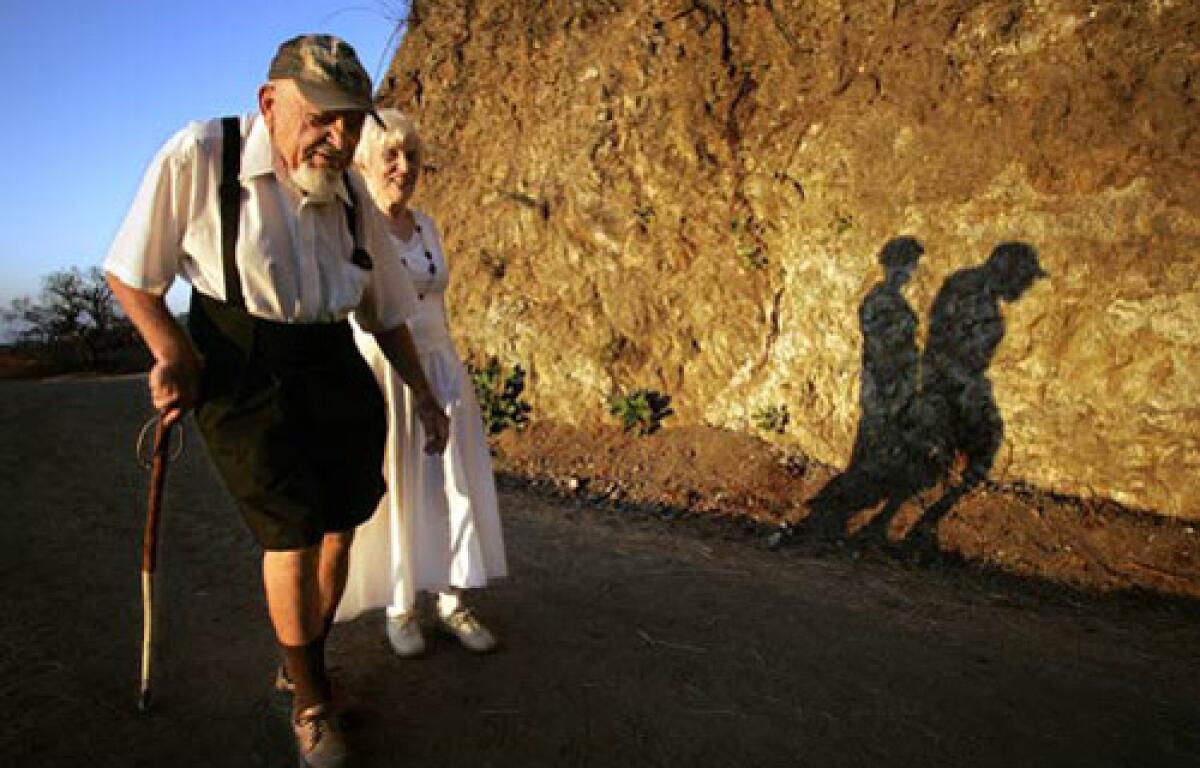For L.A. man, 93, life is a walk in the park

The weight of time has bowed Sol Shankman’s spine into the shape of a question mark. After 93 years, he is blind in one eye and nearly blind in the other. His voice, except for brief bursts of animation -- when he’s imitating a mud lark, for instance -- sounds like a handful of gravel.
“But the way I see it, you’ve got two choices,” he said the other day. “You can sit at home and weep for yourself. Or you can get out and do the best you can.”
And so, every evening, at his home just above Los Feliz Boulevard, Shankman sets his alarm clock for 5 a.m. Every morning, his eyes open five minutes before the alarm, and he sets off into the hills.
He has been walking for more than three decades, pretty much every day -- 42,000 miles, by his reckoning, the vast majority of it in Griffith Park. The circumference of the Earth is roughly 25,000 miles, “so I figure,” he said, “that I’m on my second trip around the world, all in Griffith Park.”
Shankman is among a handful of people -- like Charlie Turner, caretaker of Dante’s View; and Louis Alvarado, the park’s “honorary mayor” -- who have asked a diffuse, fast-paced city to stop and remember that one of the largest city parks in the world is smack in the middle of L.A.
Shankman’s story is not one of physical prowess but of relentless dedication -- to an urban park, to the restorative capability of a nice walk and to Los Angeles and its extraordinary topography, to which he attributes most of the city’s foibles and charms.
He has never graduated to backpacking, not for a single night. (“I like a bed.”) In a time of ultramarathons, he rarely walks more than four miles at a time. Once, he did seven. (“Never again.”)
In recent years, his pace has slowed to a shuffle, his size 8, resoled Eccos often moving just six or eight inches with every step. He figures his eyes and legs are racing to do him in; these days the eyes, beset with macular degeneration, are winning. One day, he said, he just won’t be able to take his walk. When that happens, he’s not sure what he will leave behind.
“I’m like the elevator operator in an old building,” he said. “Everybody knows him. Then he retires. Nobody knows the new guy. Then they get rid of the elevator operator altogether. Next thing you know, nobody remembers there was an elevator operator to begin with. I’ve just been here for so many years. I’m not special.”
Those who know him -- who see him every morning -- do not agree.
From his first days in the park, Shankman has been one of its great ambassadors.
He has held court about a field of wild mustard in Cedar Grove, about a colony of rabbits running wild above Roosevelt Golf Course, about the day he rounded a corner near Beacon Hill to find that a film crew had filled a hot canyon with fake snow.
He has picked up scores of stray golf balls and delivered them to a charity thrift shop, sprinkled seeds from a golden rain tree growing in his backyard and carried gallons of water up to nurture struggling fields of poppies.
The way his admirers tell it, Shankman has helped turn the park into a community, a place you go not to get away from the city but to revel in it.
By now, he is a fixture. The other morning, a group of power moms raced by. (“Hi, Sol!” they said in unison.) George DiCaprio, a comic book artist, the actor Leo’s father and a park regular, pulled up his mountain bike to chat. Tom LaBonge, an L.A. city councilman in the hills for a workout, pulled over in his car when he saw Shankman.
“The sun is coming up,” LaBonge told him. “We live to see another day!”
Shankman smiled and stepped onto a trail across from the Greek Theatre.
“I’ll tell you something you’re allowed to say when you’re my age,” he said with a shrug. “It’s good for the ego. It really is.”
He was never an athlete. “I might have been what you call a ‘nerd’ today,” he said.
Shankman earned his doctorate in physical chemistry at the University of Toronto after studying the vapor pressure of sulfuric gas solutions. With his wife, Elizabeth Stern Shankman, a pathologist whom he’d met at college in 1935, he moved to Los Angeles after school and started working for a vitamin company.
His bosses asked him to design a pill that would stop gray hair. He tried -- but in the process stumbled upon a bacterial medium that helped speed up scientists’ ability to isolate proteins and other material. In 1944, he hung his own shingle -- Shankman Labs, where he analyzed everything from pharmaceuticals to Army rations.
Along the way, he discovered Griffith Park, 4,467 acres of scrub oak and chaparral -- and more than 50 miles of trails. “I was in love with it from the first day,” he said.
In 1976, after he began suffering from angina, friends suggested he start hiking.
“At first, it was principally therapeutic,” he said. “But I just kept on walking.”
After his wife passed away in 1980, around the same time that he sold his business, he decided that he needed a project. He walked from Tijuana to San Francisco over seven years, all in tiny increments of three or four miles at a time. Later, he founded a group of walkers dedicated to the steep staircases that zigzag across eastern portions of the metropolis, particularly in Echo Park and Silver Lake.
But, mostly, he stuck to the park up the street, the park that would sustain him, the park that he says is the city’s “lungs.”
He has walked through driving rain -- indeed, he has been known to stoop down and kiss the ground at the onset of the rainy season -- and has twice broken ribs in nasty falls, walking the next day in both instances.
He’s become picky about his walking partners -- a right of age, perhaps.
He hates to walk alone but, on the other hand, “you find out how boring some people can be if you walk with them every day,” he said. “And I include myself in that.”
Most days, he walks with his companion, 81-year-old Anneliese Clay, whom he met after she moved into her daughter’s house in his neighborhood seven years ago. They spend their time talking about European history, doting on woodpeckers and other critters, bickering over the identifications of unusual plants they stumble across.
“Sol understands that you need nature, that you need to walk -- that it improves your spirit,” Clay said. “He lives what he says. That is his principle.”
In August, LaBonge -- who became close with Shankman after the park’s terrible 2007 wildfire chased Shankman off his regular trail -- and several other lovers of the park dedicated a little red bench to Shankman.
“He’s an inspiration,” LaBonge said.
The bench is on Riverside Trail, east of the Greek Theatre and not far from Cedar Grove. It’s easy to find; they put it under a formidable live oak, the only shade tree for several hundred yards in any direction.
“It’s not Shangri-La,” Shankman said. “But with a little shade, it’s a nice spot.”
If you get there early enough, you might see Shankman coming around the bend, the rotunda of the Observatory rising over his head, an orange in his pocket, stabbing the agave walking stick he plucked from a neighbor’s rubbish pile into the dirt with every other step. “It’s nice when you see people above you, up on the slopes, when the sun is rising right behind them,” he said. “Everybody looks like a saint.”
More to Read
Start your day right
Sign up for Essential California for news, features and recommendations from the L.A. Times and beyond in your inbox six days a week.
You may occasionally receive promotional content from the Los Angeles Times.







